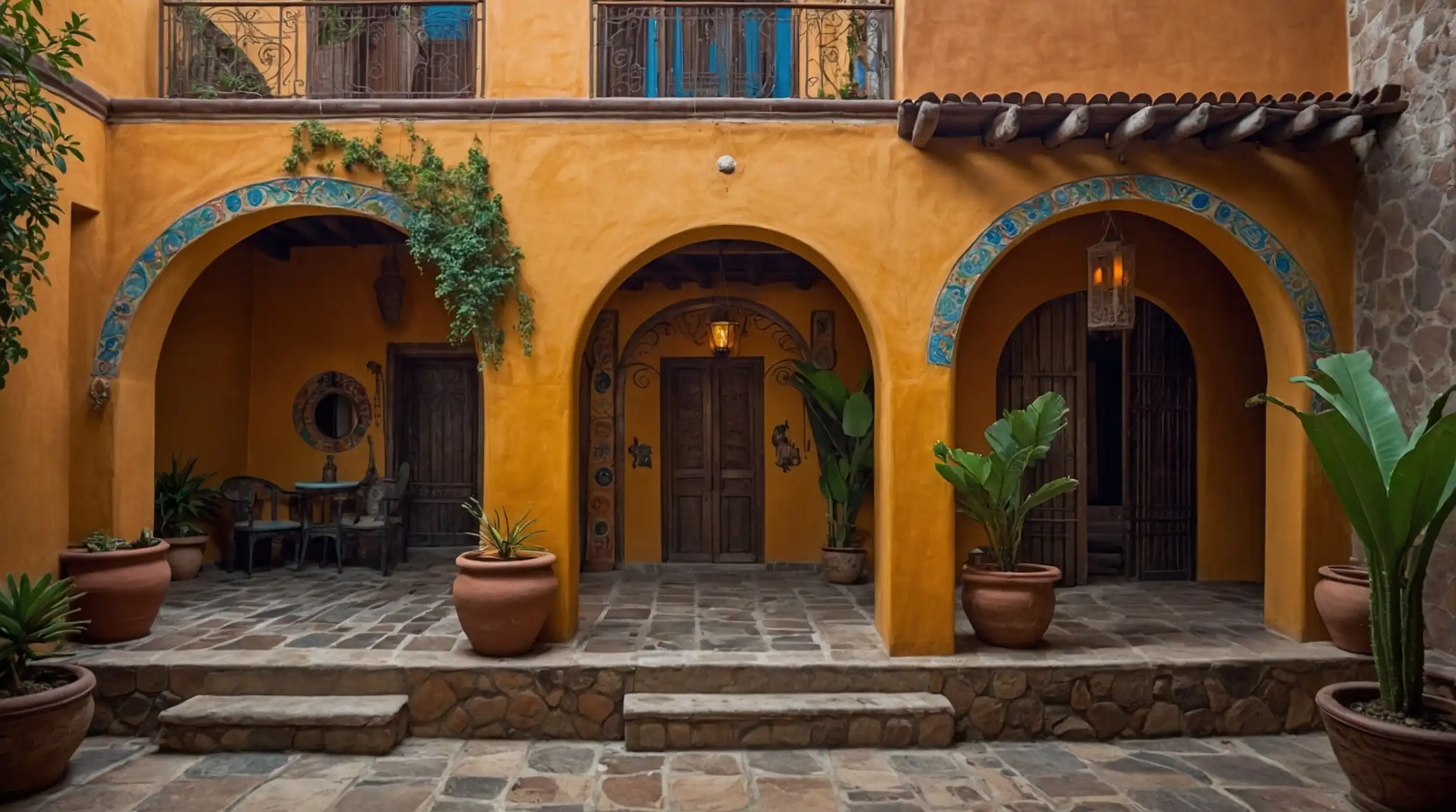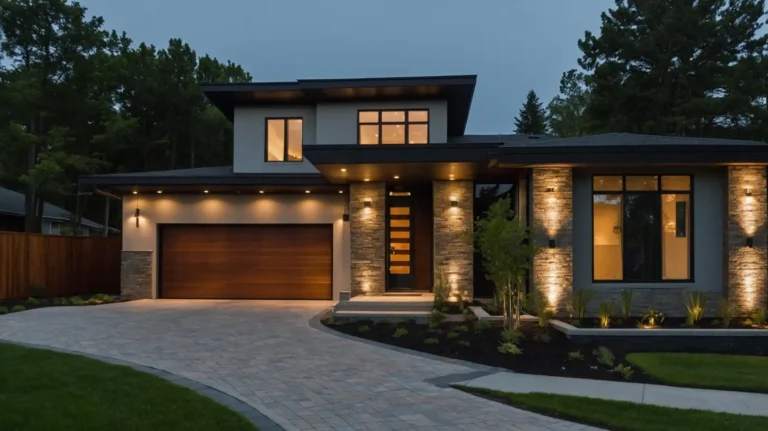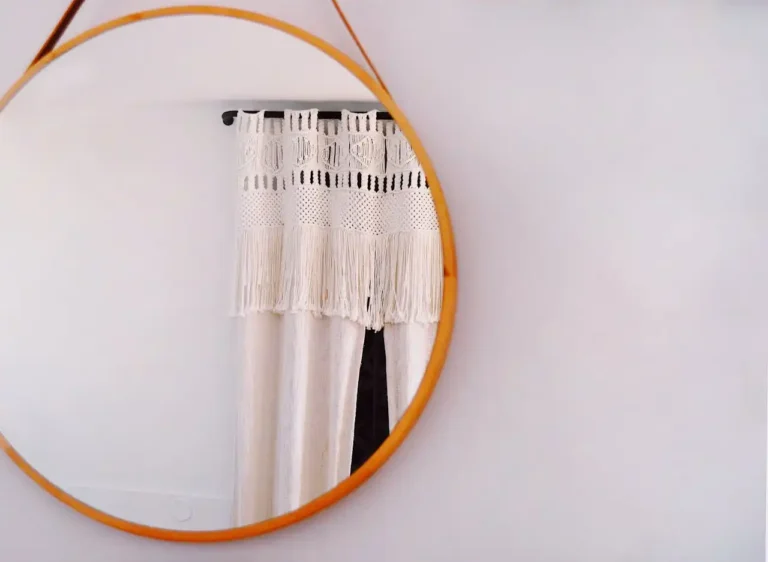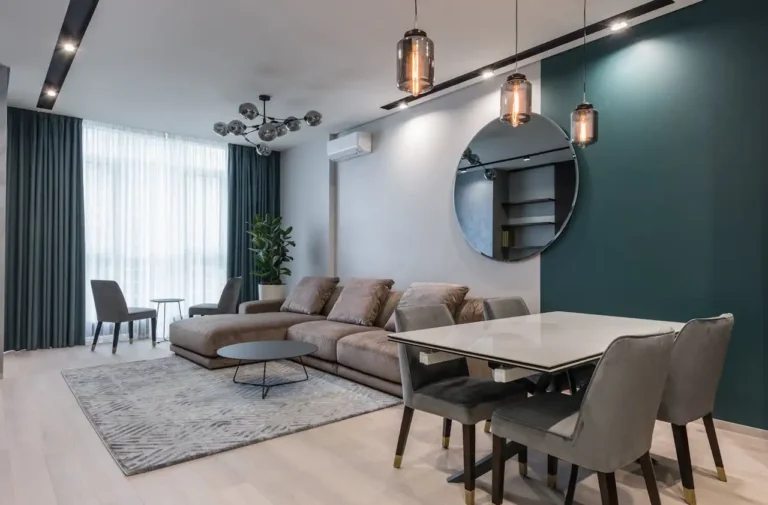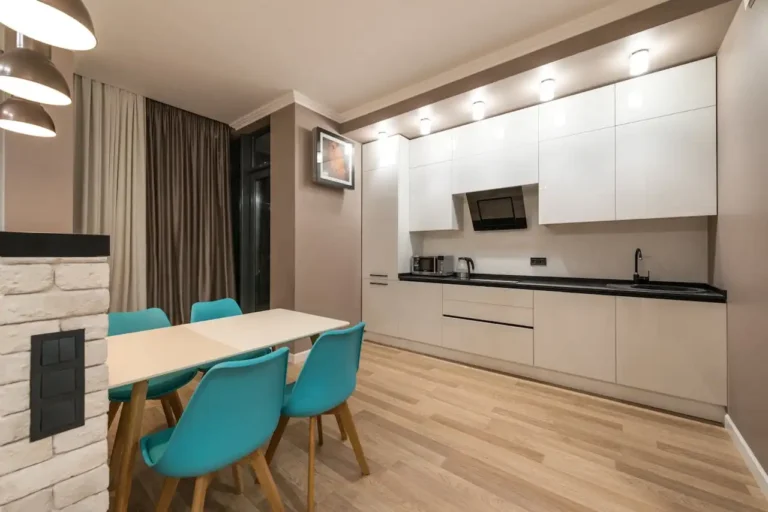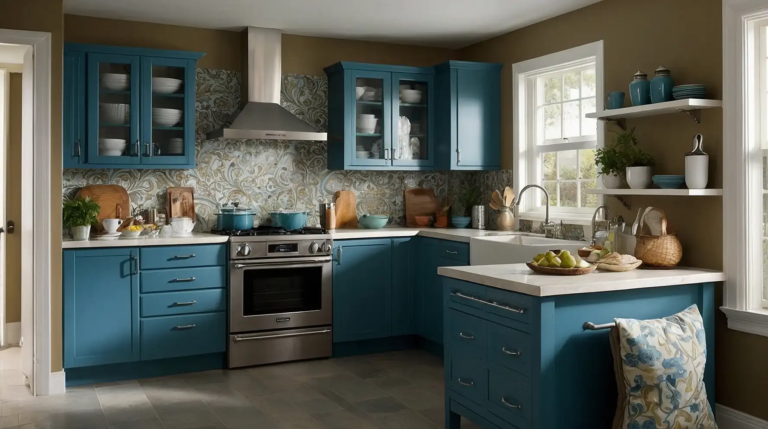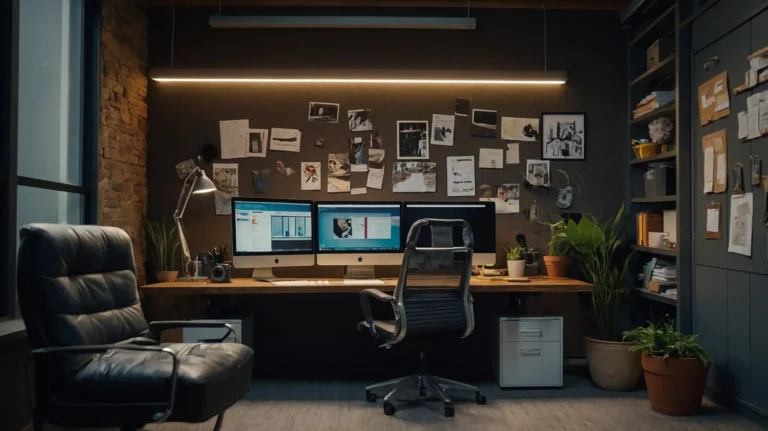27 Captivating Old Mexican House Ideas to Transform Your Home with Timeless Charm
Traditional Mexican architecture blends indigenous influences with Spanish colonial elements to create spaces brimming with character and warmth.
These historic designs offer a wealth of inspiration for contemporary homes seeking authenticity and cultural richness.
From colorful facades to intimate courtyards, old Mexican houses showcase practical design solutions perfectly adapted to their environment.
The thoughtful integration of indoor and outdoor living creates harmony with nature while celebrating craftsmanship.
Whether you’re renovating an existing property or building from scratch, these ideas from Mexico’s architectural heritage will help you create a home with soul, history, and unmistakable charm.
1: Central Courtyard (Patio Central)
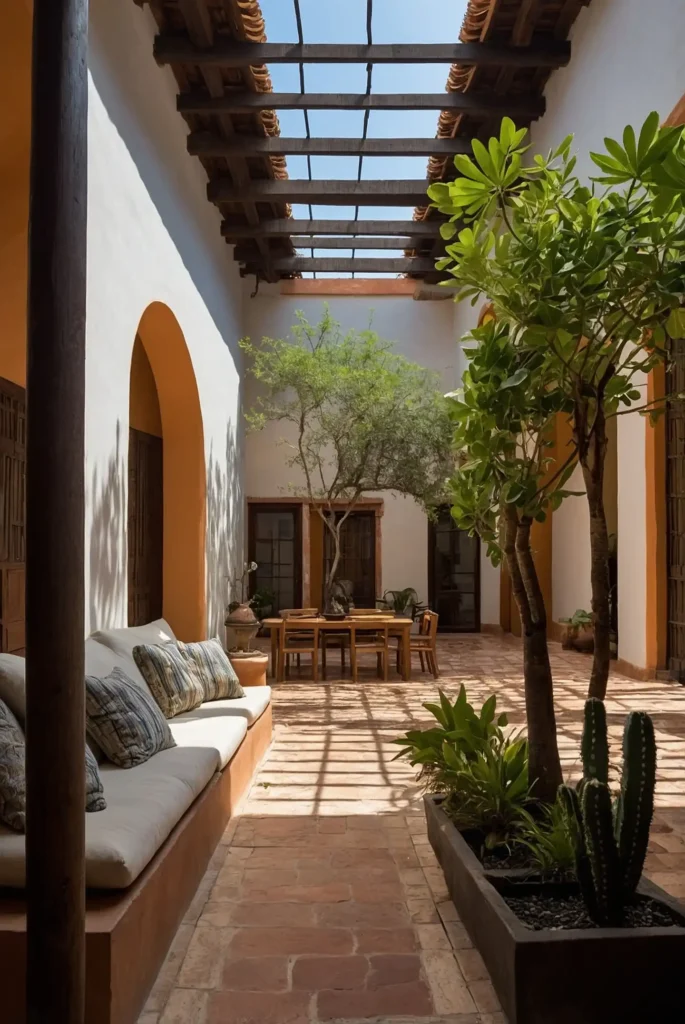
Design your home around a traditional central courtyard that serves as the heart of the household.
This classic Mexican element provides natural ventilation, brings in light, and connects indoor spaces to nature.
Surround the courtyard with corridors (corredores) that create comfortable transitional spaces.
dd a central fountain or small garden to enhance the sensory experience.
Consider how rooms can open directly onto the courtyard to maximize the indoor-outdoor connection throughout your home.
2: Vibrant Exterior Color Palette
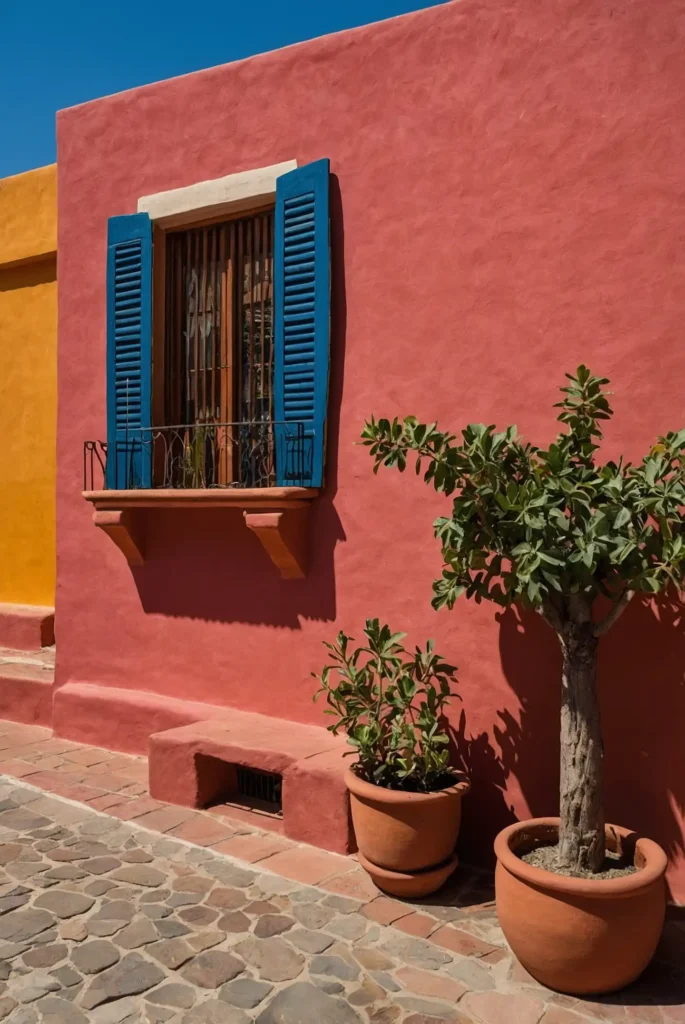
Embrace the bold color traditions of Mexican architecture with vibrant exterior walls.
Think terracotta reds, cobalt blues, sunshine yellows, and deep pinks that reflect the country’s cultural vibrancy.
Create contrast with bright white trim around windows and doors.
Consider color combinations traditional to specific regions like Oaxaca or San Miguel de Allende.
Remember that natural aging and weathering will add character to these colors over time, enhancing their authenticity.
3: Exposed Wooden Beams (Vigas)
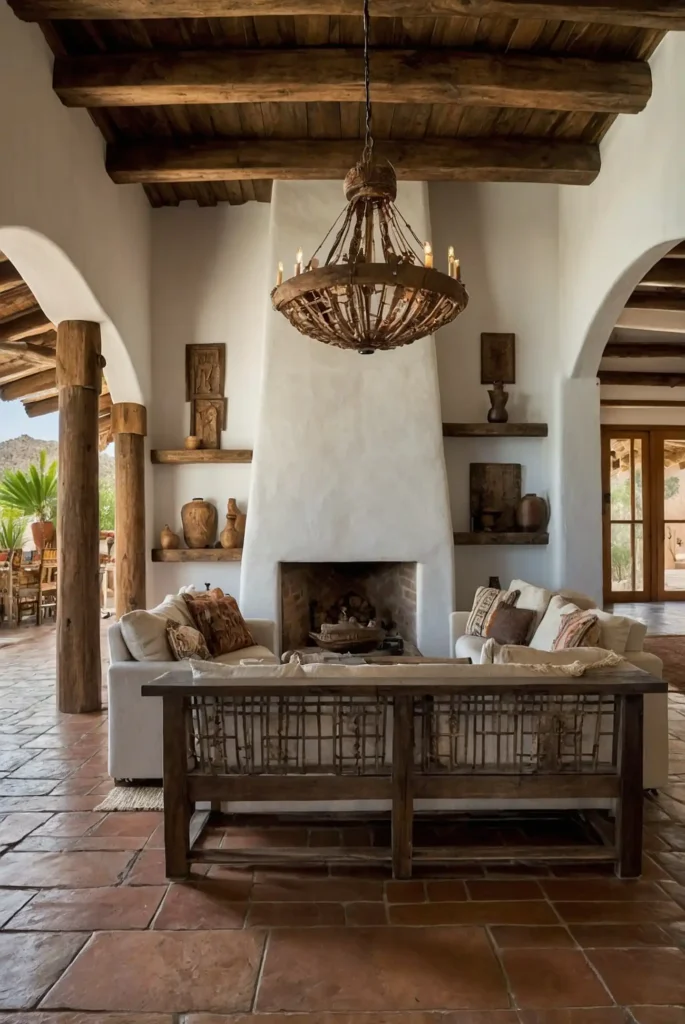
Incorporate rough-hewn wooden ceiling beams that extend through exterior walls.
These structural elements, known as vigas, are signature features of old Mexican and Pueblo architecture.
Leave the wood natural or stain it dark for dramatic contrast against white ceilings.
Complement these horizontal elements with vertical wooden posts (morillos) for authentic character.
Consider varying the diameters and spacing of these beams for a more organic, handcrafted appearance.
4: Talavera Tile Accents
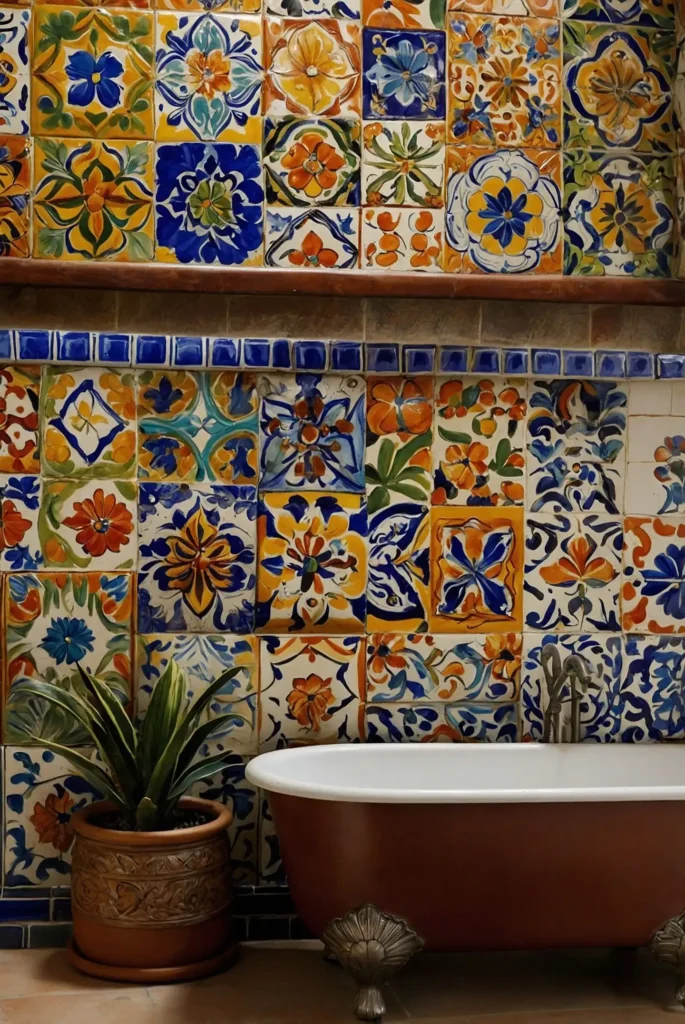
Integrate handpainted Talavera tiles into your home as colorful focal points.
These ceramic treasures from Puebla bring instant Mexican heritage to kitchens, bathrooms, and outdoor spaces.
Use them as kitchen backsplashes, stair risers, or bathroom accent walls.
Create a custom mural featuring traditional patterns or nature motifs.
Mix tiles with different patterns while maintaining a consistent color palette for a cohesive yet vibrant look.
5: Thick Adobe-Style Walls
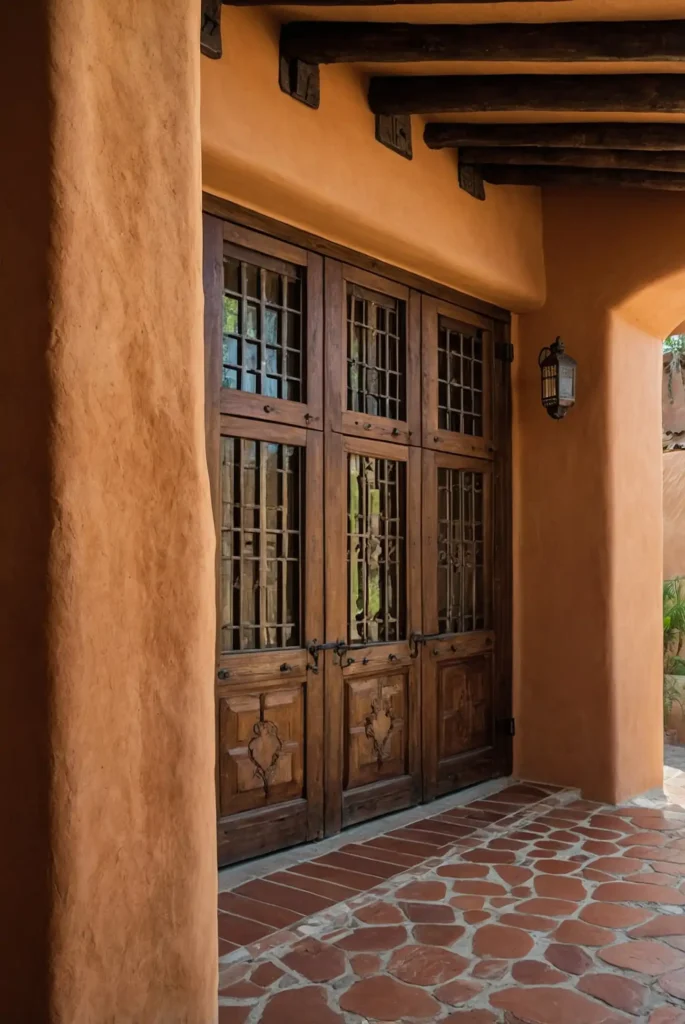
Construct or simulate the substantial earthen walls typical of traditional Mexican architecture.
These thick barriers provide excellent thermal mass, keeping interiors cool during hot days and warm during cool nights.
Create deep-set windows and door openings that showcase the wall thickness.
Round the corners and edges for the authentic hand-formed appearance of true adobe construction.
Consider modern adaptations like insulated concrete forms or straw bale construction with adobe finish for improved energy efficiency.
6: Wrought Iron Details
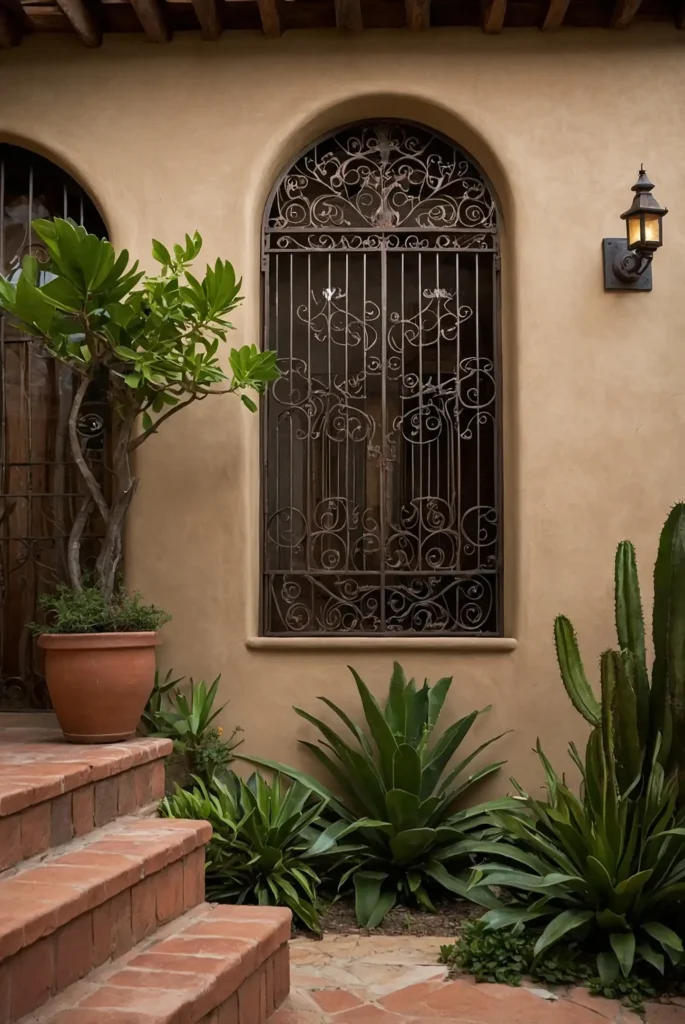
Incorporate handcrafted wrought iron elements throughout your home as both decorative and functional features.
This quintessential Mexican design element adds artistic detail and security.
Install decorative iron window grilles (rejas) that allow ventilation while maintaining privacy.
Add statement lighting fixtures, stair railings, and garden elements in complementary ironwork designs.
Look for artisans who can create custom pieces that reflect traditional Mexican motifs and craftsmanship.
7: Arched Doorways and Windows
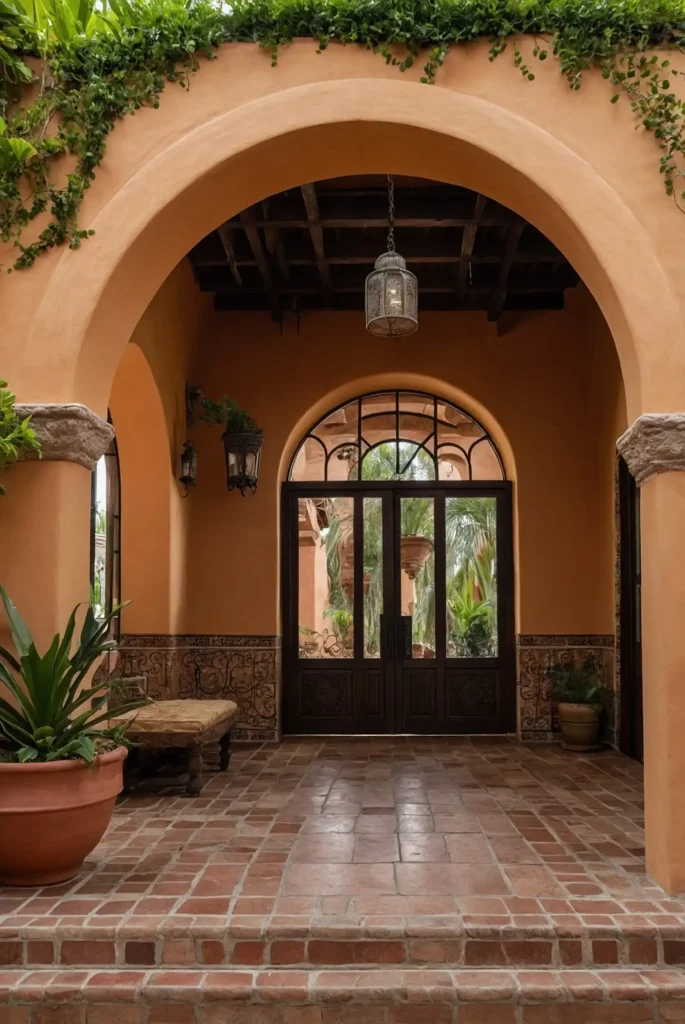
Design with graceful arches (arcos) that soften transitions between spaces and add architectural interest.
These curved elements reflect Spanish colonial influence on Mexican design.
Vary the width and height of arches to create visual rhythm throughout your home.
Consider different arch styles from simple semicircular to more elaborate horseshoe or Moorish forms.
Use arches consistently as a unifying design element connecting indoor and outdoor spaces.
8: Terra Cotta Floor Tiles
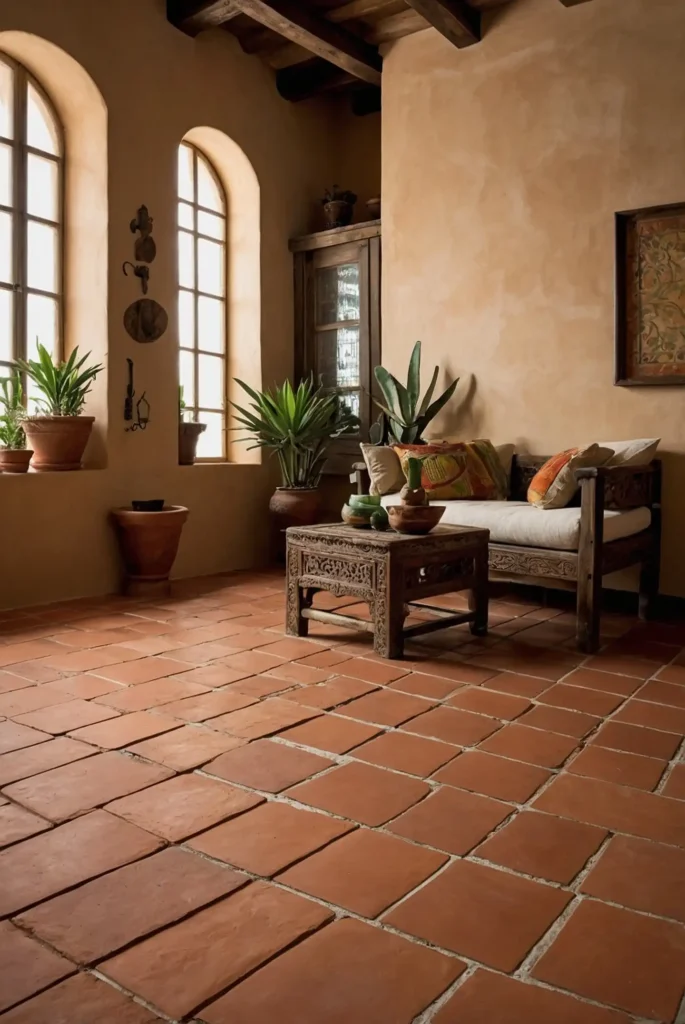
Install handmade terra cotta floor tiles (baldosas) to bring warmth and earthiness to your living spaces.
These traditional clay tiles develop a beautiful patina over time that enhances their character.
Choose tiles with slight irregularities and color variations for authentic handcrafted appeal.
Consider traditional patterns like hexagons or squares with decorative corner accents.
Apply natural oil or wax finishes rather than modern polyurethanes to maintain their breathable quality and natural appearance.
9: Indoor-Outdoor Flow
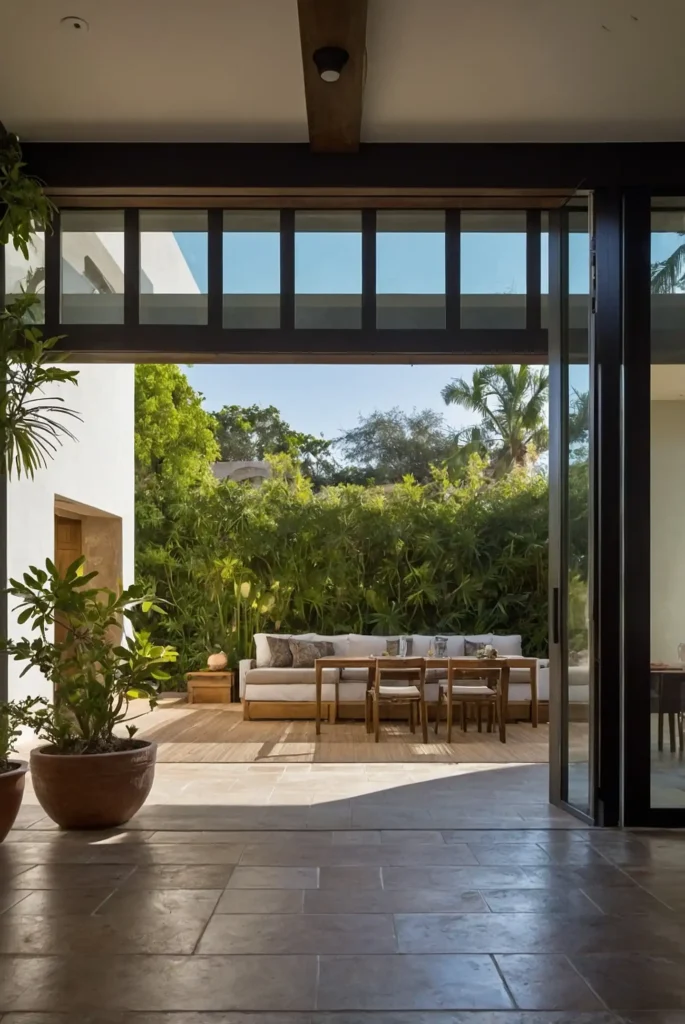
Design your home with seamless connections between interior rooms and outdoor living spaces, reflecting the Mexican tradition of living in harmony with nature and climate.
Install large, operable doors that can completely open to connect rooms with patios or courtyards.
Create covered outdoor cooking and dining areas that function as extended living spaces.
Use consistent flooring materials that flow from inside to outside, reinforcing the connection between spaces.
10: Carved Wooden Doors
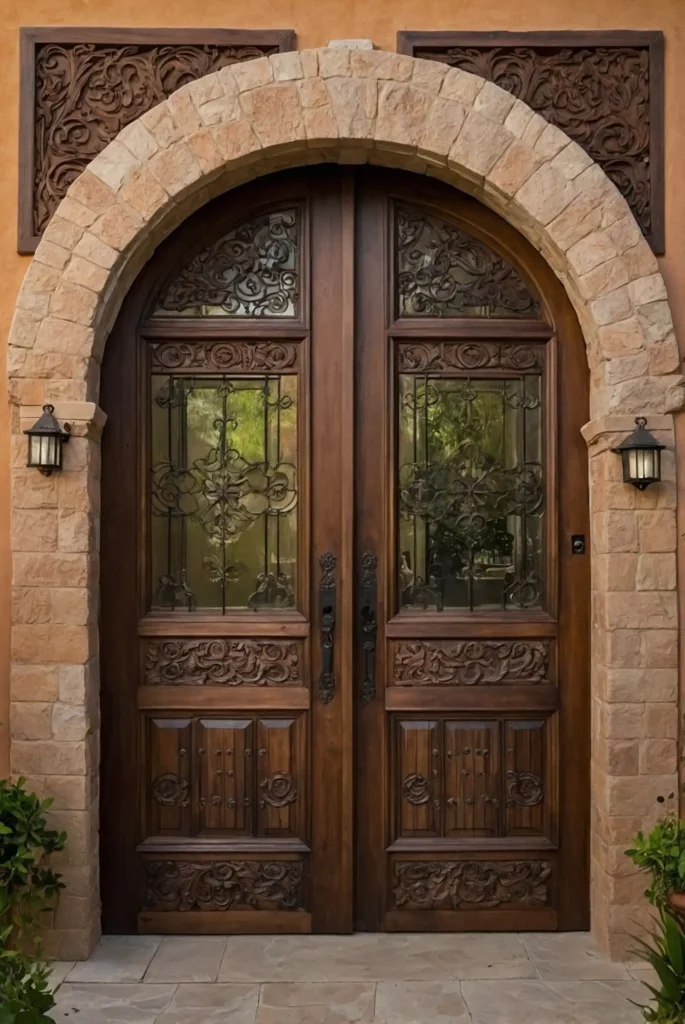
Install substantial wooden entry doors with carved details as a dramatic focal point.
These impressive portals signal hospitality while showcasing traditional craftsmanship.
Look for reclaimed historic doors or commission replicas featuring geometric patterns or natural motifs.
Choose rich, dark wood species like mesquite or Spanish cedar traditional to Mexican carpentry.
Consider double doors with smaller inset pedestrian doors (portones) for an authentic colonial touch.
11: Nicho Wall Recesses
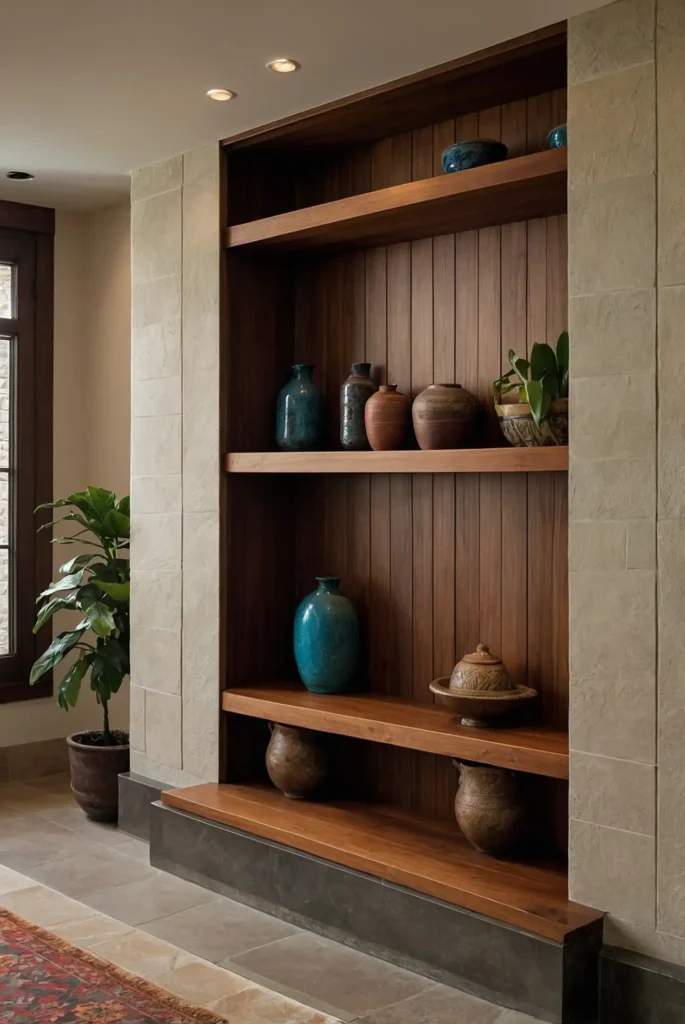
Incorporate small recessed shelves (nichos) into thick walls as display areas for art, religious items, or decorative objects.
These architectural features add character while serving practical purposes.
Vary the sizes and placements of nichos throughout your home. Paint the interiors of these recesses in contrasting colors for visual impact.
Consider adding lighting within larger nichos to highlight displayed objects and create ambient illumination.
12: Rustic Wood Furniture
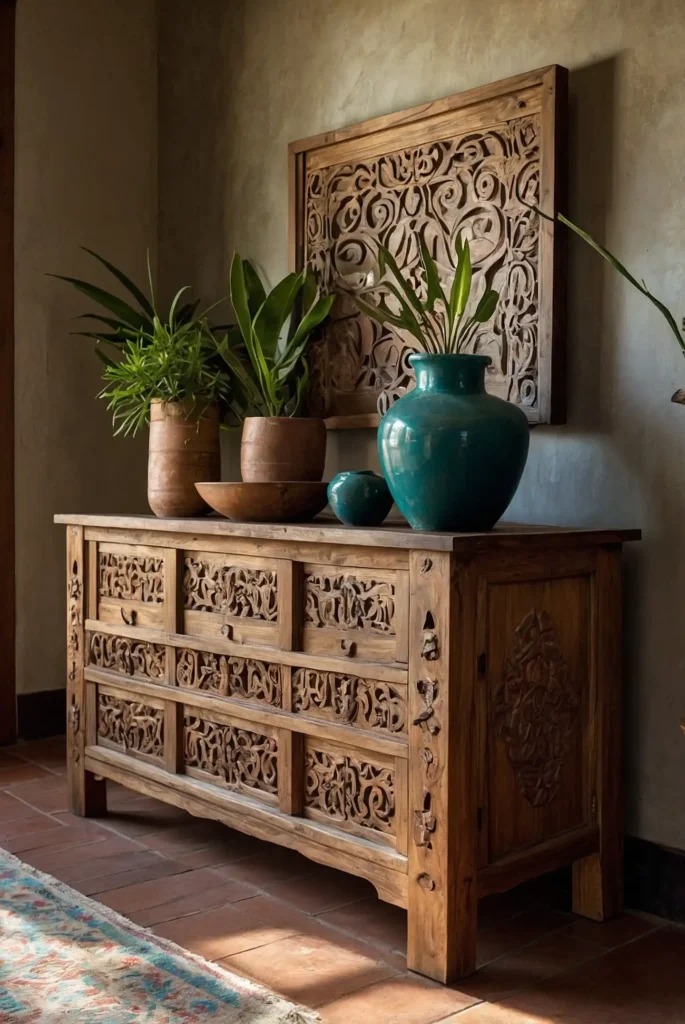
Furnish your home with handcrafted wooden pieces that reflect Mexico’s rich tradition of carpentry.
Look for designs with simple, sturdy construction and minimal ornamentation.
Choose pieces made from regional woods like pine, mesquite, or cypress.
Mix furniture with different wood tones and patinas for an evolved, collected look.
Look for traditional forms like equipales (barrel chairs), trasteros (cupboards), and banco (benches) with rawhide or woven seats.
13: Clay Tile Roofing
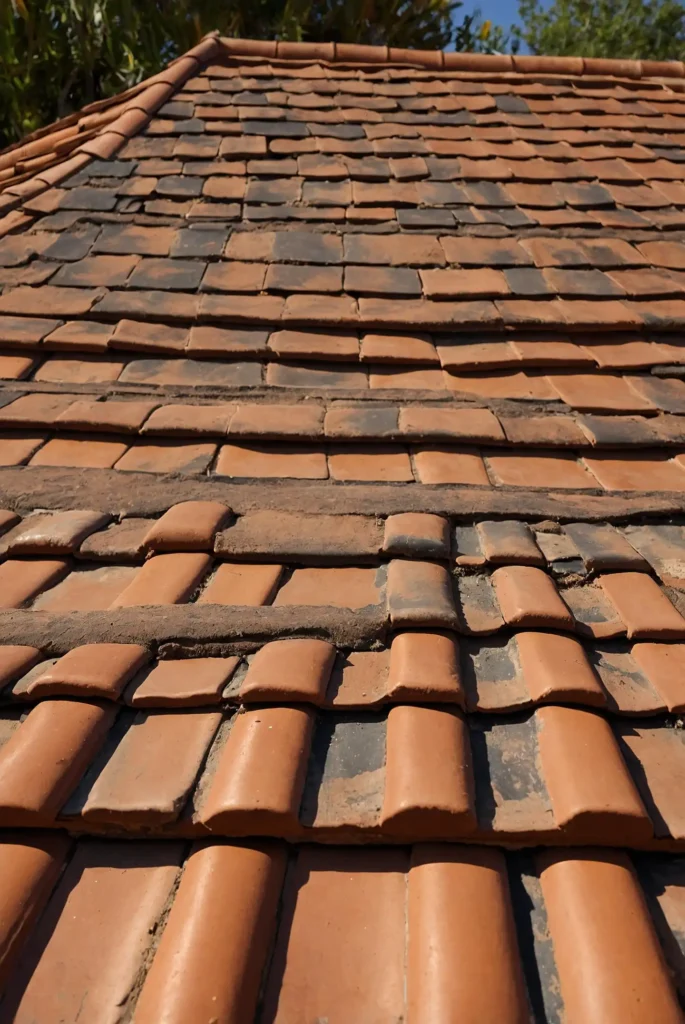
Top your home with traditional clay barrel tiles (tejas) that create distinctive wavy rooflines characteristic of Mexican architecture.
These durable roof coverings age beautifully while providing excellent protection.
Allow for generous roof overhangs that protect walls from sun and rain.
Consider exposed wooden rafters (vigas) that extend beyond exterior walls as traditional support for these heavy tiles.
Choose tiles with variations in color and texture for an authentic, time-weathered appearance.
14: Tiled Kitchen Countertops
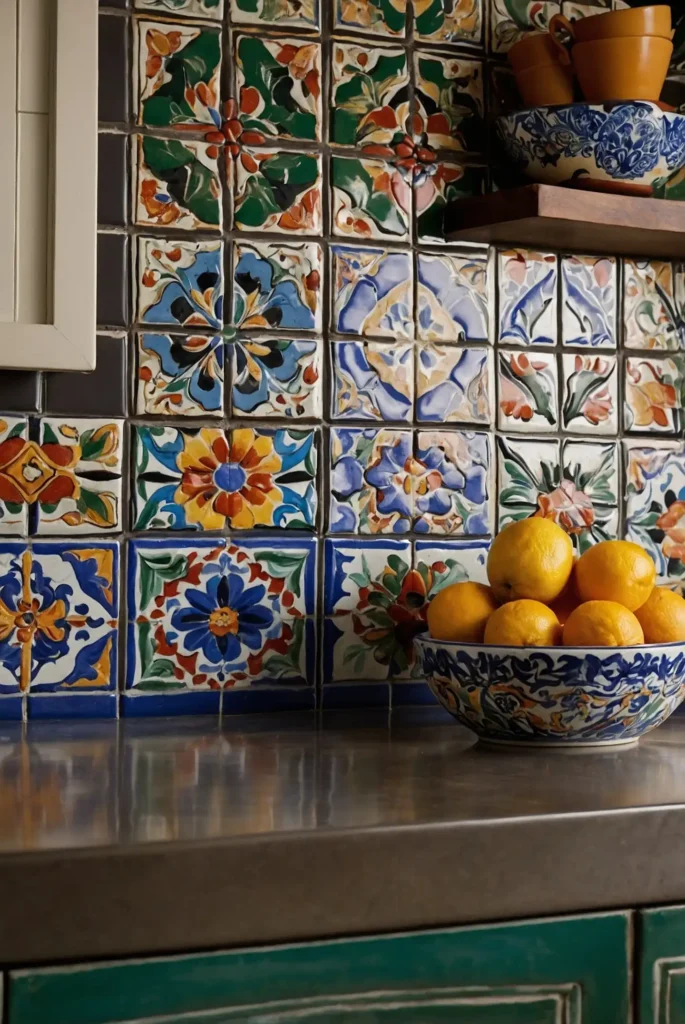
Create colorful, functional kitchen work surfaces using ceramic tiles set in concrete.
This traditional approach allows for creative expression while providing durable, heat-resistant countertops.
Choose handpainted tiles for decorative borders or create patterns using solid colors.
Consider carrying the same tiles from countertops to backsplashes for visual continuity.
Ensure proper sealing of grout lines while maintaining the handcrafted character essential to authentic Mexican design.
15: Wooden Window Shutters
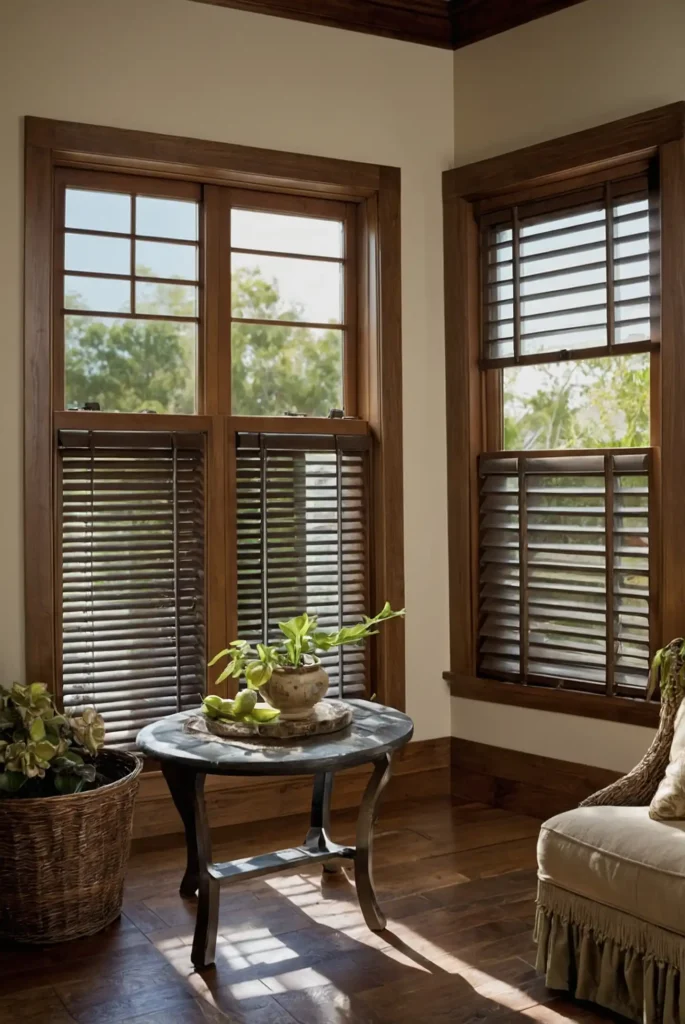
Install operable wooden shutters that provide security, privacy, and climate control.
These traditional window treatments add architectural detail while serving practical functions.
Choose designs with adjustable louvers or fixed panels depending on your climate needs.
Paint shutters in colors that complement or contrast with your exterior walls.
Consider interior shutters for bedrooms and bathrooms as an alternative to contemporary window coverings.
16: Bóveda Ceiling Techniques
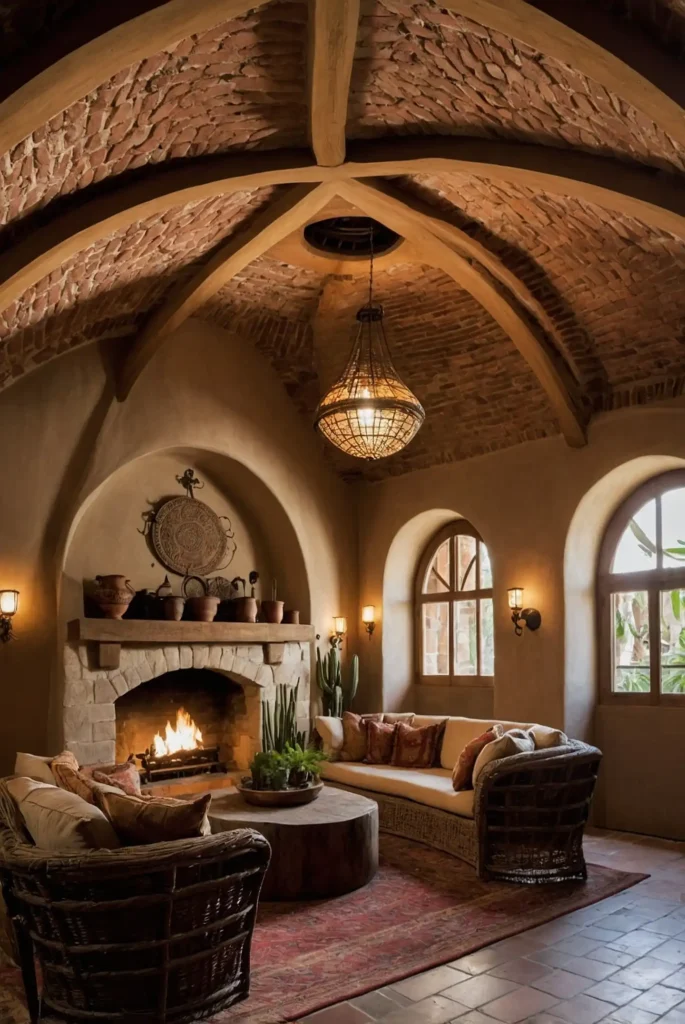
Incorporate curved brick or plaster ceilings (bóvedas) that create dramatic interior spaces.
These self-supporting structures represent an indigenous engineering solution that eliminates the need for wooden supports.
Choose from various styles including barrel vaults, groin vaults, or dome shapes.
Consider exposing the brick pattern in some areas while plastering others for textural contrast.
Install thoughtful lighting that highlights the dimensional quality of these architectural features.
17: Enclosed Gardens (Jardines)
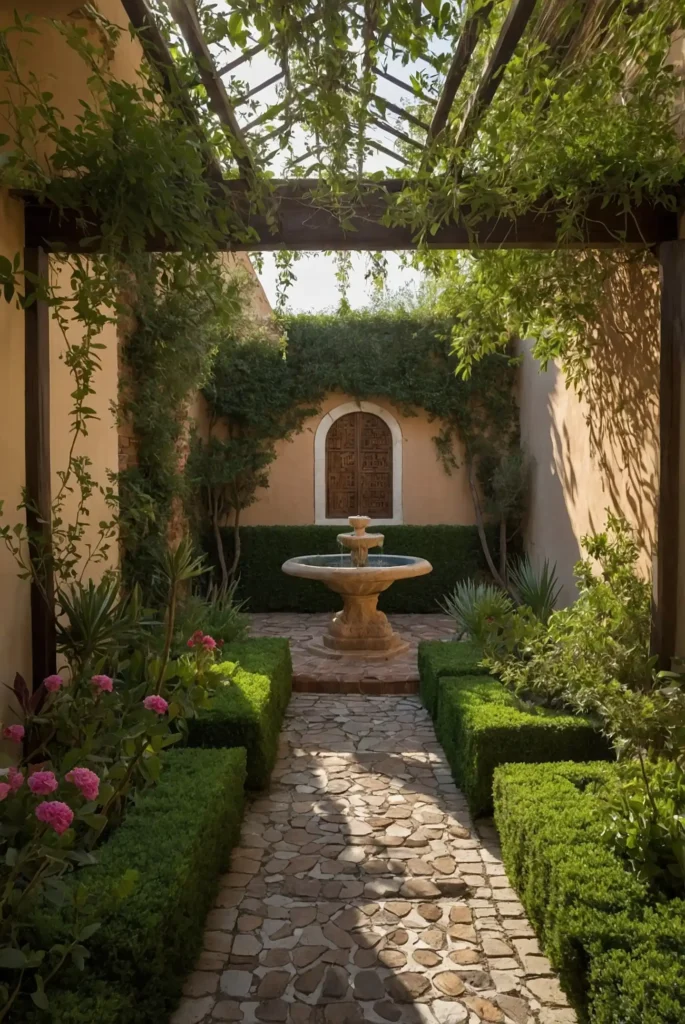
Create private garden spaces enclosed by walls rather than open lawns.
These intimate outdoor rooms reflect the traditional Mexican approach to landscape design.
Plant flowering vines, fruit trees, and aromatic herbs traditional to Mexican gardens.
Incorporate water features like fountains or reflecting pools that add cooling effects and gentle sounds.
Design various garden “rooms” with different characters connected by pathways or portals.
18: Stone Wall Construction
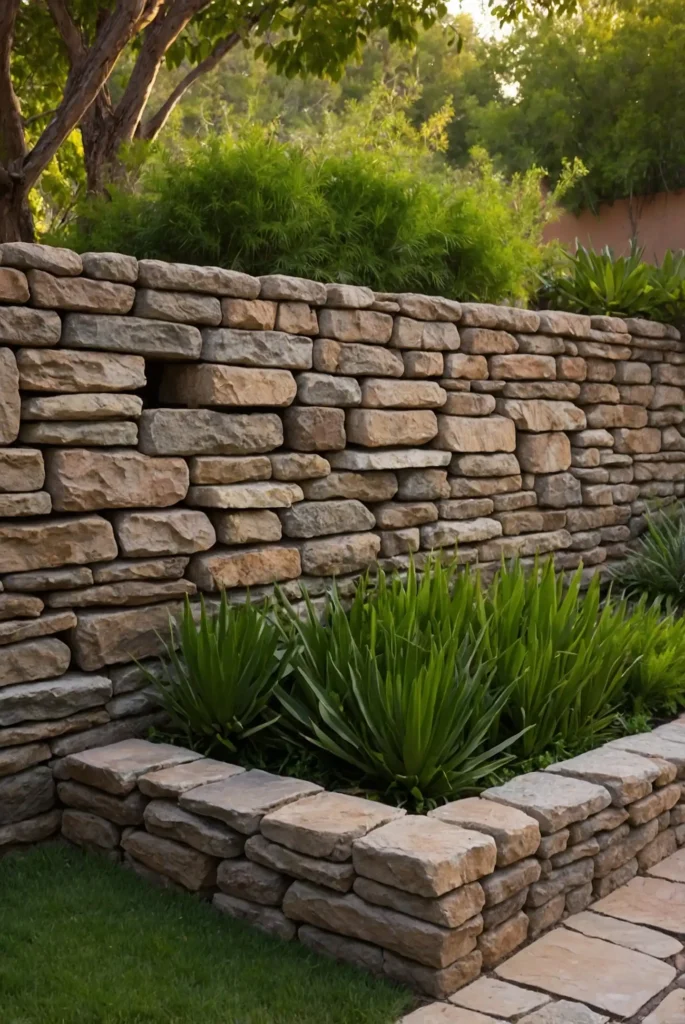
Build or face walls with locally-sourced stone using traditional Mexican masonry techniques.
These substantial structures connect your home to the surrounding landscape while providing durability.
Choose stones with varied colors and textures for visual interest.
Consider leaving some stones projecting from the wall surface (salients) as a traditional detail.
Use wide mortar joints with a rough texture rather than precise modern techniques for authentic character.
19: Built-in Seating (Bancos)
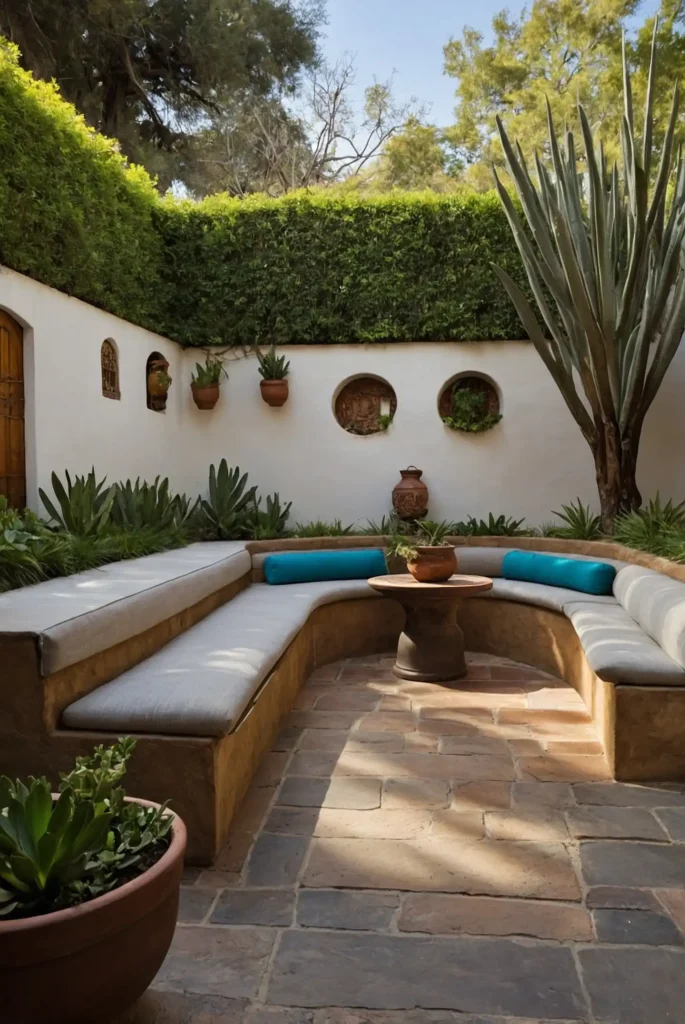
Incorporate permanent masonry seating areas along walls and in outdoor spaces.
These built-in elements provide casual gathering places while eliminating the need for additional furniture.
Top bancos with colorful cushions or Mexican textiles for comfort and style.
Design curved forms that encourage conversation in courtyards and garden areas.
Consider incorporating storage space beneath seating or adding niches above for displaying decorative items.
20: Open-Concept Kitchen (Cocina)
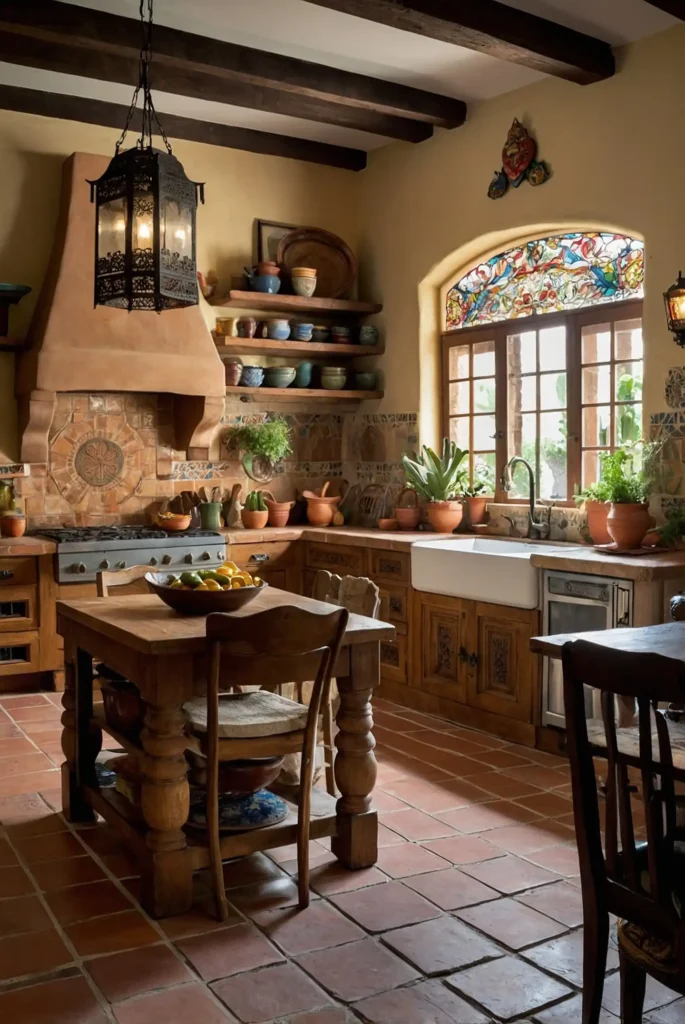
Design a traditional open kitchen with visible cooking areas that invite participation and create a warm family gathering space.
Mexican kitchens historically served as the heart of the home.
Install a large wood-burning hearth or contemporary interpretation as a central feature.
Incorporate open shelving for displaying colorful dishware and cooking implements.
Add a substantial wooden table in the center for food preparation and casual dining.
21: Decorative Plaster Techniques
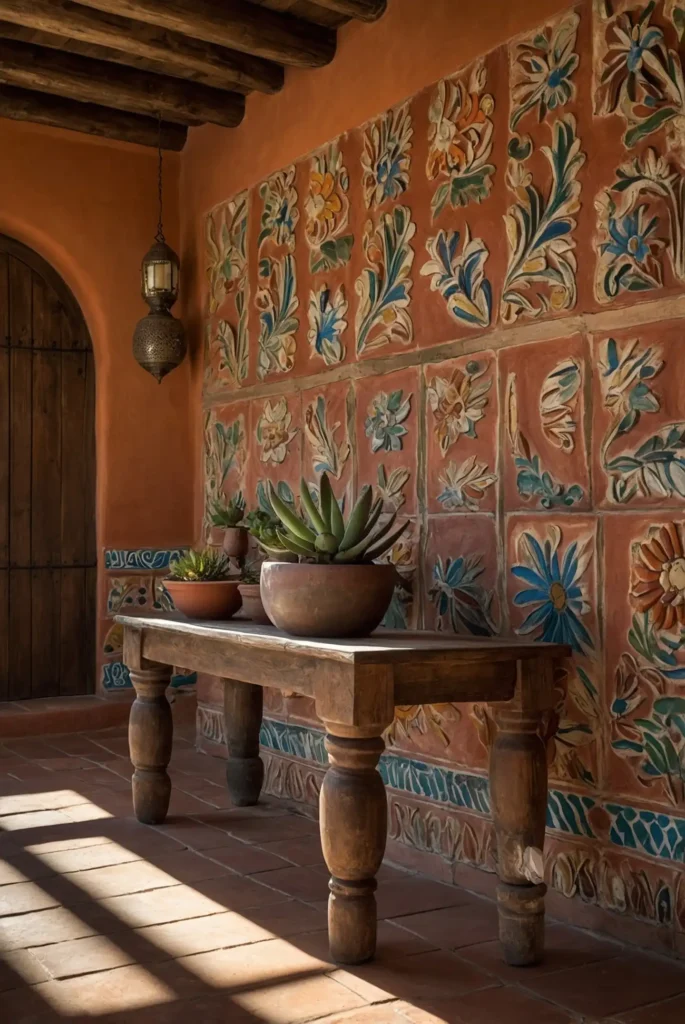
Apply textured plaster finishes to interior and exterior walls using traditional Mexican techniques.
These handcrafted surfaces add dimension and character while allowing walls to breathe.
Experiment with different textures from smooth aplanados to more rustic textures.
Consider colored plasters that incorporate natural earth pigments for depth and warmth.
Allow for organic imperfections that reflect the handmade quality central to Mexican architectural tradition.
22: Outdoor Cooking Areas
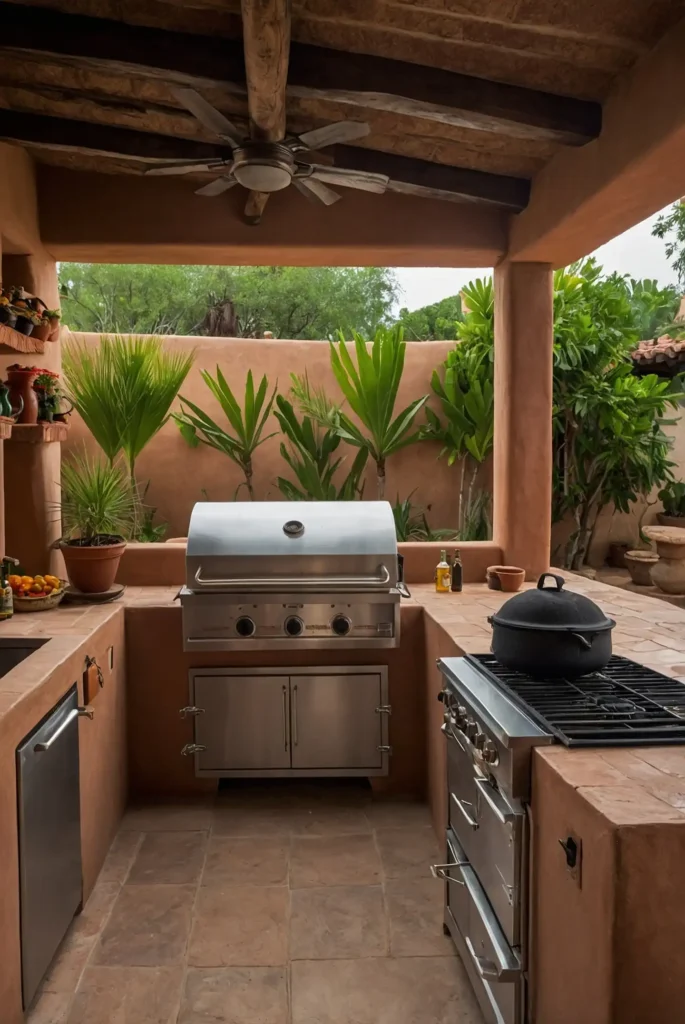
Create dedicated exterior cooking spaces inspired by traditional Mexican kitchens.
These functional areas extend your living space while keeping heat and cooking odors outside.
Install wood-fired ovens (hornos), grills, or traditional comal cooking surfaces.
Incorporate prep areas with rustic countertops and sinks for complete functionality.
Design overhead shelter that protects from sun and rain while allowing smoke to escape naturally.
23: Interior Courtyards (Patios)
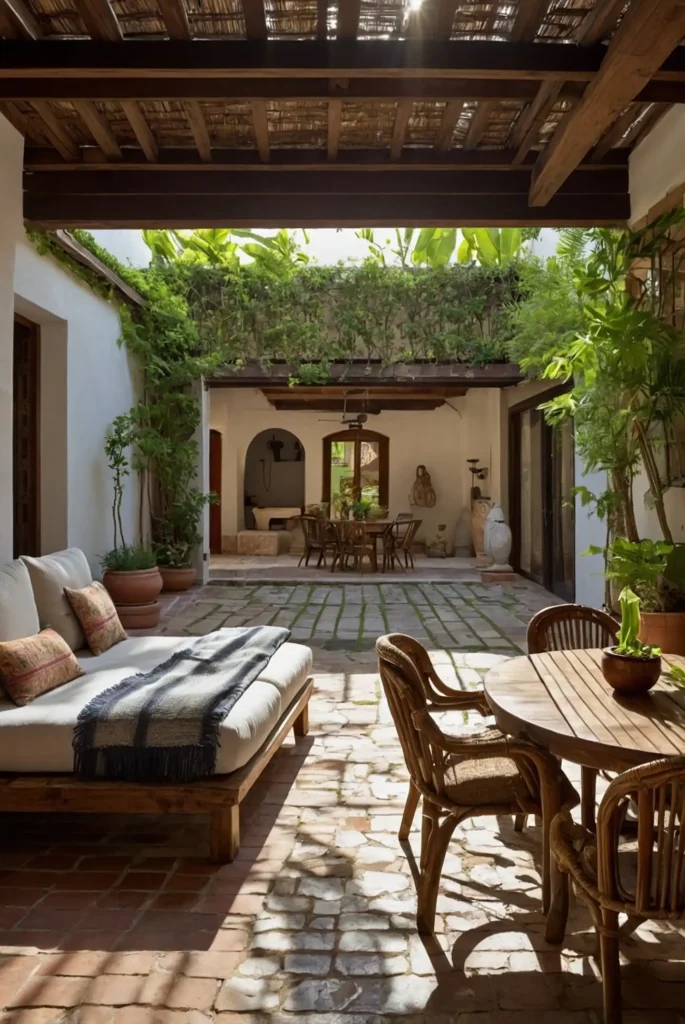
Design secondary interior courtyards that bring natural light and ventilation to bedrooms and private spaces.
These intimate outdoor rooms create tranquil retreats within the home.
Scale these spaces appropriately as quiet contemplative areas rather than main gathering spots.
Plant fragrant flowering vines and shade trees appropriate to your climate.
Consider water elements that provide cooling effects and gentle background sounds.
24: Cantera Stone Features
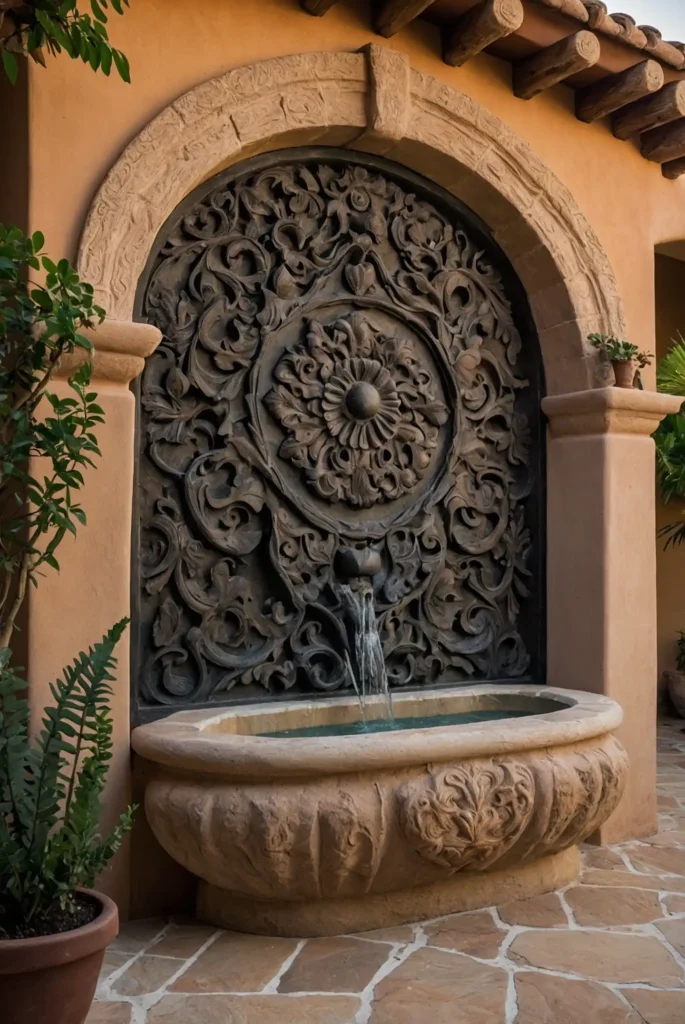
Incorporate architectural elements carved from cantera, the volcanic stone traditionally used throughout Mexico.
These distinctive features add elegance and permanence to your home.
Commission custom columns, fountains, fireplace surrounds, or door frames in this versatile material.
Choose color variations from rose and gray to green or black depending on the quarry source.
Allow these carved elements to weather naturally, developing patina that enhances their character over time.
25: Boveda Staircase
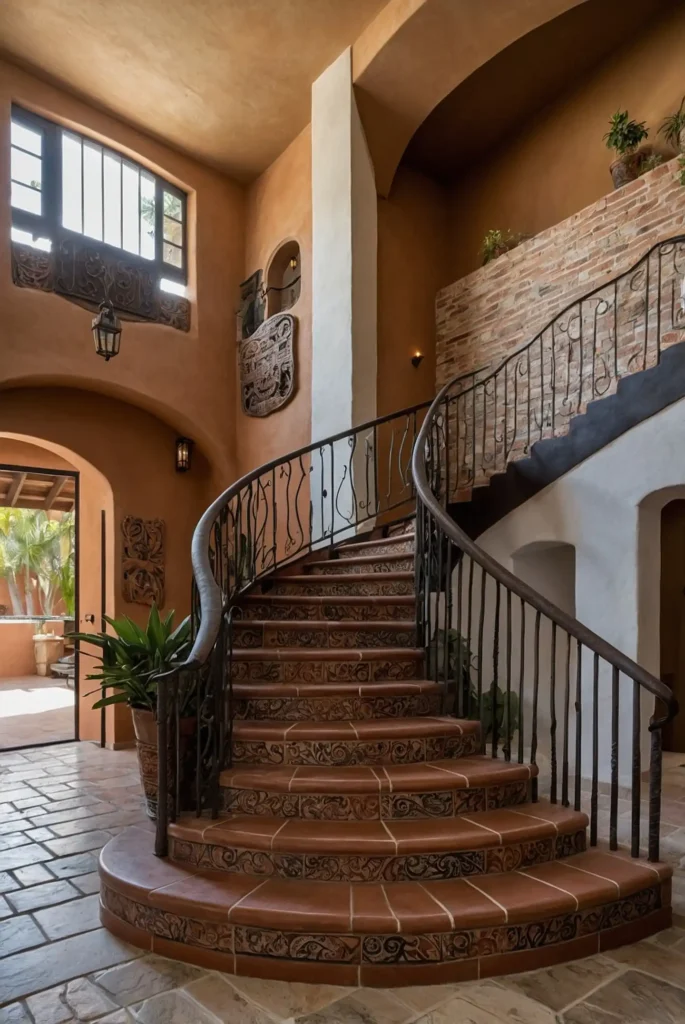
Design curved staircases using the boveda brick technique to create dramatic vertical transitions between floors.
These self-supporting structures showcase traditional Mexican engineering.
Leave brick exposed or apply plaster finishes depending on your design aesthetic.
Install handcrafted tile risers that add color and pattern to the ascent.
Consider iron railings with traditional Mexican motifs to complement the architectural form.
26: Zaguan Entry Hallway
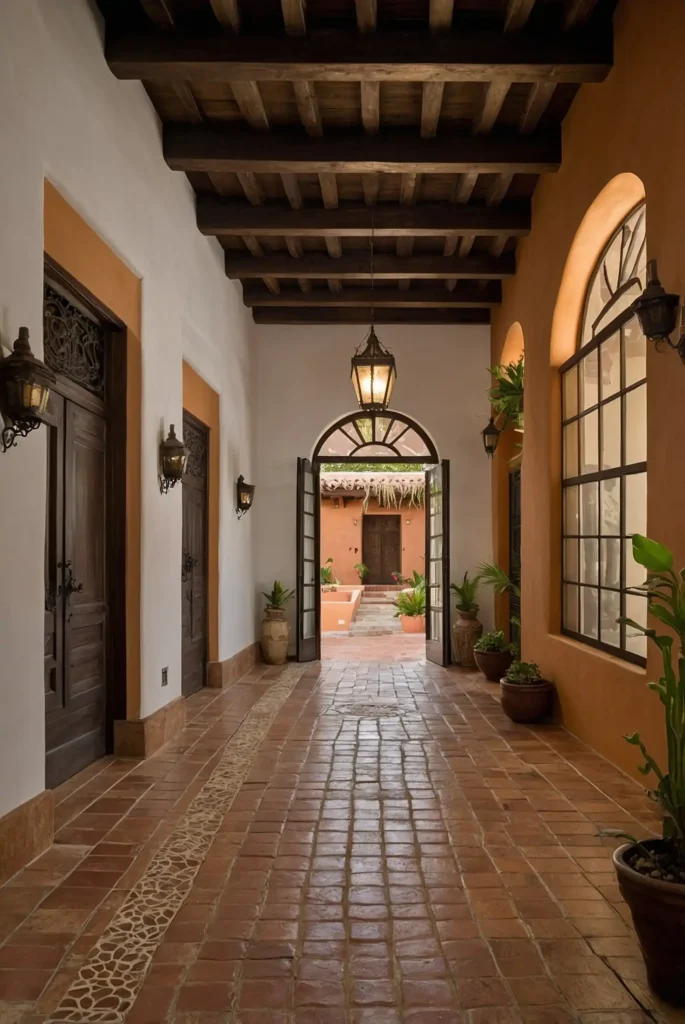
Create a traditional entry passage (zaguan) that transitions between public street and private courtyard.
This signature element of colonial Mexican architecture provides security and privacy.
Design the zaguan wide enough to accommodate historical carriage access.
Install substantial wooden entry doors that open to reveal glimpses of interior courtyards.
Consider traditional floor patterns using stone or tile that welcome visitors while transitioning them into your home.
27: Rooftop Living Spaces (Azoteas)
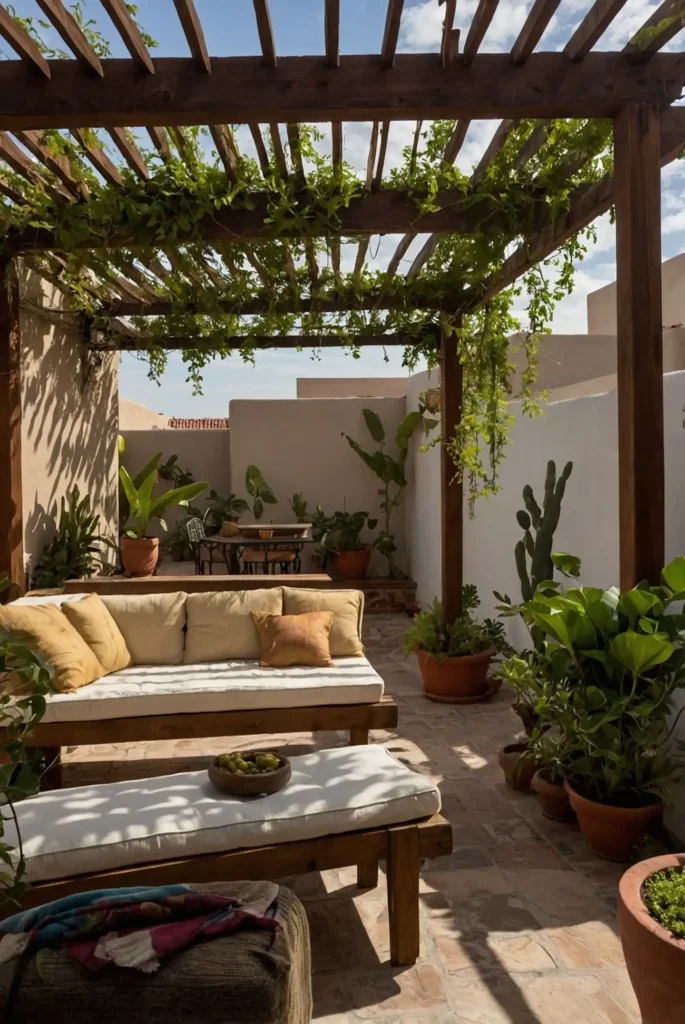
Develop your roof as an additional living area following centuries-old Mexican traditions.
These elevated spaces provide private outdoor areas with excellent views and cooling breezes.
Create various functional zones for dining, lounging, and container gardening. Install pergolas or partial roofing for shade in strategic areas.
Incorporate traditional parapets and detail elements that enhance safety while maintaining architectural authenticity.
Conclusion
By incorporating these traditional Mexican design elements, you’ll create a home with authentic character, environmental harmony, and timeless appeal.
Embrace these ideas as inspiration while adapting them to your lifestyle and local context.

